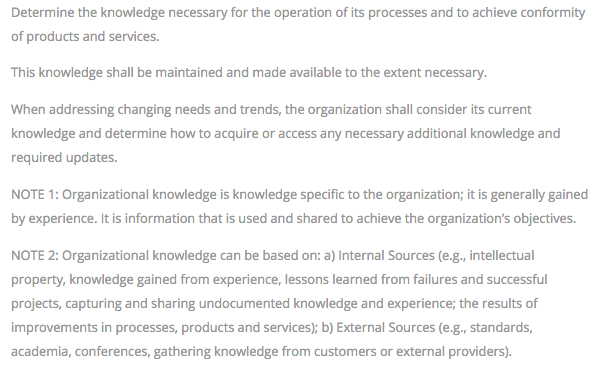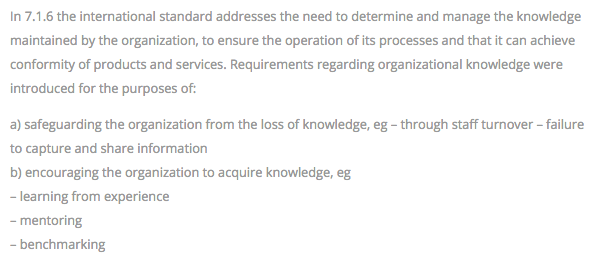What has the inclusion of KM in ISO 9001 :2015 brought to the organisations?

Having surveyed about 15000 people worldwide to deduce what was missing in the ISO 9001 :2008 quality standards which needed to be included, the International Organization for Standardization (ISO) ended up with an overwhelming answer: “managing knowledge”.
This was not a surprise as managing knowledge was regarded as a valuable business practice in an organisation, therefore a new clause was added to ISO 9001:2015 and this clause brought a huge change within the world of Knowledge Management.
The clause that changed KM world:
To understand the importance of this change, we must explain the use of ISO certificates in organisations.
ISO 9001 is the most widely applied standard for Quality Management systems, used to set requirements which will enable organizations to improve their performance and to benefit from the implementation of a robust quality management system.
Over a million ISO 9001 certificates are awarded each year and must be renewed at regular intervals recommended by the certification body.
These ten clauses and two annexes encompass guidelines from Leadership, Planning, Operations to Support, which had included Organisational Knowledge under the requirements for Resources:
Clause 7.1.6. - Organisational Knowledge

With this clause, one of the global business standards explicitly mentions organisational knowledge as a resource, together with people and infrastructure, and specifies expectations for the management of that resource. This means that sufficient attention must be paid to managing knowledge to ensure good and consistent quality of services and goods.
How?
Well, there are many elements of the knowledge management process that the organisation will need to implement in order to comply with the standards. Some of the elements are outlined in this excerpt:

What is required here is very similar to what knowledge management processes deliver.
So what have these requirements brought to organisations, now, when they are a part of the ISO 9001 certificate?
Senior management is more open to implementing knowledge management practices
To senior management, knowledge management is no longer a “good thing to do” but a “requirement for ISO certification in the area of Quality”, which is a massive change to the way it has been perceived. Although an organisation applying for ISO 9001 :2015 certification is audited based on multiple requirements, we may say that auditors are looking for evidence that the organisation has:
- Identified knowledge topics
- Assigned a person/persons responsible for the knowledge on these topics
- Created an appropriate procedure for managing that knowledge
- Generated a procedure that makes this knowledge available
- Produced an effective plan that will identify actions required to fill knowledge gaps from external resources
- Developed a program for knowledge retention and transfer
An organisation which has invested in these practices is sure to start reaping benefits very soon.
Organisations are provided with a set of regulations that present the basis of the KM process
Let’s assume that the organisation would like to invest in KM and doesn’t know where to start. It is not as simple as buying a software, as we’ve written in our free e-book. These set of regulations are very similar to the knowledge management process advised by many experts and can help avoid many mistakes the organisations make.
The process was beautifully outlined in an article by APB consultant through an example:
| 7.1.6 Requirements |
Organization: Large 24 hour food retailer Process location: 9 food checkout counters Process: ‘Food checkout’ |
| 1. What knowledge is necessary here? |
Security protocols for handling/retaining customer money in counter cash box, operation of bar code reader, operation of moving food belt, suspect theft protocols, getting help, keying in discounts and food codes, customer food packing, abuse/violence protocols, credit/debit card payments, cash back. |
|
2. How is this knowledge maintained within the organization? |
All protocols and activities above are maintained in documented information by the Quality Manager with Human Resource (HR) assistance. |
| 3. How is it made available? | Through the organization’s intranet portal, and available to all persons (to the extent necessary) working for it. Also contained in hard copy format at each checkout counter (version and distribution controlled). Also made available through the shift managers. |
| 4. Are there any changing needs / trends? | Yes, promotion codes sold by other retailers that add points to a customer’s rewards card (incentives schemes). |
|
5. Is any additional knowledge required for (4.)? How is this to be acquired/ accessed? |
Yes, how to scan these codes in to add points to their reward card, and give a rewards discount on purchases made. IT Systems workforce are to train and write instructions to be included in the documented information above. |
| 6 Required updates? | Frequent, as promotion codes change monthly. Suggest a monthly check on changes/ knowledge needed. |
The organisation working through these requirements will surely find their weak spots and challenges soon and take appropriate action to address them.
In seeking to meet the new organisational knowledge requirement, it is vitally important that proven practices and processes are used, or valuable resources will be wasted and desired outcomes not achieved.
One of these resources is, of course, the appropriate technology with an adoption strategy which we’ve written about in our latest blog post.

Comments
Leave a comment